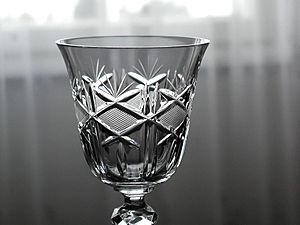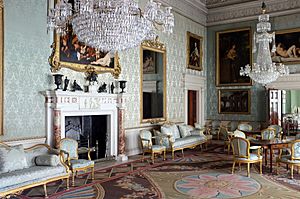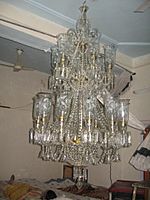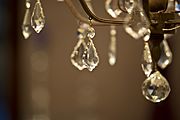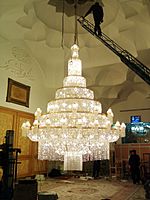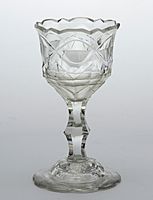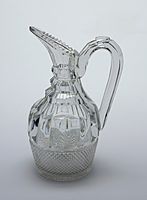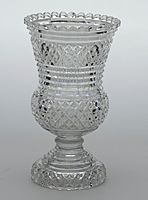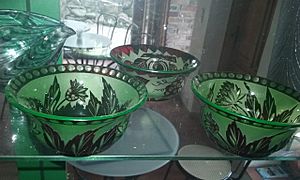Cut glass facts for kids
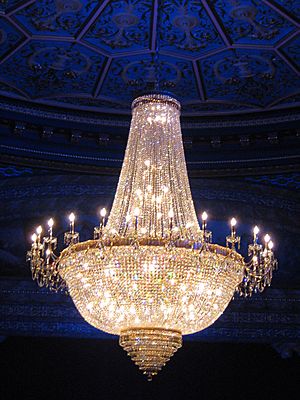
Cut glass is a special way to decorate glass. It involves cutting patterns into the glass surface. While today some cut glass looks are made using moulds, the original method uses an abrasive wheel. This creates detailed patterns of angled surfaces. For drinking glasses, you'll see furrowed patterns. For chandeliers, you'll find flat or curved pieces that hang and sparkle. In the past, glass was shaped by grinding or drilling after it was blown. Now, it's often shaped by a mould or even made from clear plastic. Real hand-cut glass is still made, but it costs a lot more.
Two main types of items are made with cut glass. First, there are drinking glasses, decanters, and jugs. Second, there are chandeliers and other light fixtures. Both started appearing in England around 1730. This was after a special type of clear lead glass was developed there. This glass had a high refractive index, meaning it bent light a lot. Cut glass needs thick glass because parts are cut away. Older clear glass would look cloudy if made thick enough. Today, some pieces still follow old styles, while others use modern designs.
Before cut glass, fancy drinking glasses were often very thin. Their decoration might be inside, like bubbles or colored spirals in the stem. Or it could be on the surface, like enamelled glass or glass engraving. In Europe, light fittings didn't use much glass before. But cut glass "drops" changed this. These small, faceted pieces were like cut gems. They bent and spread light in a new, exciting way. Makers and customers loved them! Chandeliers often had a metal frame. But this frame was usually hidden by many sparkling glass pieces held by wire.
Contents
How is Cut Glass Made?
The way cut glass is made hasn't changed much over time. It uses a small spinning wheel covered with a rough material. Water, sometimes mixed with sand, drips onto the glass as it's being cut. This helps to lubricate and cool the glass. In the past, people used foot pedals to power the wheels. By the mid-1800s, steam engines powered workshops. Today, electric power is used. For flat cuts, a spinning table called a "lap" is used, similar to gem cutting.
Usually, the design is drawn on the glass with paint before cutting. In England, red paint is often used. One good thing for makers is that small flaws like bubbles in the glass can be hidden. These flaws would normally make a clear piece of glass useless. But with cut glass, they can be placed in the parts that will be cut away. However, if you try to imitate cut glass with moulds, the complex shapes can cause more flaws.
After cutting, the glass is polished. Traditionally, a wooden or cork wheel with "putty powder and water" was used. In the late 1800s, a new method using acid came out. This gives a duller finish and makes the edges of the cuts a bit rounder.
Making cut glass was mostly about the cost of labor. In 1888, an American industry leader said that a piece of glass costing 20 cents could have $36 worth of labor put into it!
The Story of Cut Glass
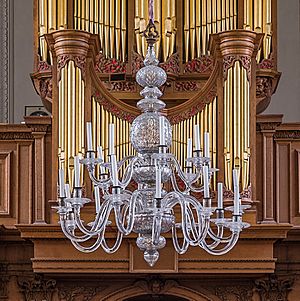
Cutting glass for decoration is actually very old. But when we say "cut glass," we usually mean pieces from the 1700s onwards. The Bronze Age Indus Valley civilization made glass beads with simple engraved shapes. Ancient Roman glass also used drilling and polishing to create amazing things. These included deeply cut cage cups and cameo glass with two colors. The Lycurgus Cup is a famous example of this.
In Islamic art, especially in Egypt, people loved bowls made from "carved" rock crystal (a clear mineral). They also made similar items from glass, which was cheaper and easier to work with. Some rare glass pieces called Hedwig glasses were probably made by Islamic artists for Europe.
Lightly scratched or cut engraved glass became popular again during the Renaissance. But deep cutting was not common for glass. It was still used for rock crystal and other hard stones. In Germany, in the late 1600s and early 1700s, there was a revival of cut decoration. It was powered by water and looked like rock crystal. This style, called Hochschnitt ("high cut"), often featured cups with coats of arms.
Later in the 1600s, George Ravenscroft in England created a cheap and reliable lead "crystal" glass. It had a high refractive index. Other glassmakers started using it. Over time, they realized this material was perfect for cut glass. The high lead content also made the glass easier to cut.
Sparkling Chandeliers
In the early 1700s, beveled edges on large mirrors became popular in England. These were made by rubbing with rough materials or by "cutting." The people who made mirrors were the ones who started cutting glass. They then began making chandeliers.
A London glassmaker advertised in 1727 that he sold "Looking Glasses, Coach Glasses and Glass Shandeliers." The first cut glass chandeliers, like the one given to Emmanuel College, Cambridge in 1732, looked like the brass chandeliers popular in England. Around the mid-1700s, designs started using many faceted pendants. These had been used in very expensive French court chandeliers, which used carved rock crystal instead of glass.
Throughout the rest of the 1700s and early 1800s, the number of hanging drops grew. The main metal part of the chandelier often disappeared behind long chains of these drops. By the Regency period, a chandelier might have "some thirty drops in perhaps six or eight graded sizes." Each drop could have 32 facets on each side. This made them very expensive! Cut glass was also used for candlesticks, sconces, and lamps, though it wasn't as dominant.
By 1800, it was common to take chandeliers apart and put them back together in a new, fashionable way. Later, most old chandeliers were changed from candles to electricity.
Fancy Vessels
Cut glass started by decorating wine glasses, decanters, and other drinkware. By the 1800s, it was used for many types of tableware. These were often for desserts, or for bowls and trays used at the table or in the living room. These larger items gave cutters more space to create interesting designs. Experts can often tell when a piece was made based on its style. Styles included Rococo, Neoclassical, and Regency. By 1840, a "Gothic" arch style appeared. The Regency style added parallel bands or flutes to the 18th-century diamond shapes. These were first narrow, then wider, in the "broad flute" style. From about 1800 to 1840, "almost all British luxury table glass was cut." This style spread to Europe and North America. English cutters even taught French workers at the Saint-Louis glass factory by 1781.
On wine glasses, the rim where you drink was left smooth. But the bowl, stem, and foot might be cut. A starburst pattern on the bottom of the foot was common. On jugs and bowls, the rim was often cut with zig-zags or other patterns. In the 1700s, cutting was often combined with glass engraving. By the 1840s, "frosting" was popular. This involved rubbing the glass to make it less transparent.
Cheaper, but lower quality, pressed glass that looked like cut glass started appearing in the 1820s. It grew a lot in the 1830s. But the British cut glass industry still grew. In 1845, someone said "cut-glass is now comparatively cheap." British glass designers could patent their designs after 1842, which helped. In America, "cutting shops" were often separate businesses. They bought plain glass from glassmakers. In the 1870s, Bohemian cutters came to Corning, New York, a center for the industry.
From 1850 Onwards
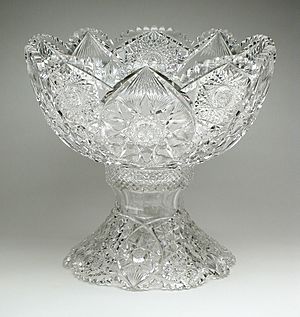
At the Great Exhibition in London in 1851, a huge glass fountain was the centerpiece. It was 8.25 meters (27 feet) tall and included a lot of cut glass. It was made by a leading firm from Birmingham. Cut glass had been very popular for decades. But now, some things started to challenge it, especially for vessels. Victorian tastes were becoming very ornate. Some cut glass at the Great Exhibition was even called "prickly monstrosities." In 1851, a famous critic named John Ruskin strongly criticized cut glass. He wrote, "We ought to be ashamed of it" and "all cut glass is barbarous." He felt it hid the glass's natural flowing look.
At the same time, the British style of cut glass spread around the world. American and Bohemian glass started to compete with British products. A tax on glass in Britain was removed in 1845. This encouraged new glass decorating styles. It also made glass cheaper, leading to many pressed glass imitations. This made cut glass seem less special. Still, cut glass remained common in wealthy British homes and was widely exported.
In the 1870s, the "brilliant," "brilliant cut," or "American Brilliant" style appeared. It might have first been seen in America at the 1876 Philadelphia Centenary Exhibition. This style covered the glass surface with many crossing cuts. These created countless small shapes that formed larger patterns. Common designs included stars, diamonds, and fan scallops.
When Cut Glass Became Less Popular
The late 1800s saw exciting new glass designs. There was a lot of color, cameo glass made with glass etching, and other new ideas. Cut glass, especially the brilliant style, didn't fit well with these. Most cut glass was always clear. An exception is the Japanese style called Satsuma kiriko. It has a thin layer of colored glass on top. This layer is then cut through, showing a color contrast. Similar effects were sometimes used in Europe. Cut glass vessels remained popular, but they were seen as more traditional. They weren't used much for "art glass," which was a new term for artistic decorative glass. This was even more true with Art Nouveau glass and the Arts and Crafts Movement. Both of these styles liked curving forms that showed the glass's liquid nature. They agreed with Ruskin's criticisms.
At the end of the century, the market for expensive decorative glass seemed to drop. Perhaps too much was being made and traded internationally. Corning's cut glass industry peaked in 1905. By 1909, the number of cutters there had fallen.
When Modernism arrived in the early 1900s, it didn't help. In 1923, an English expert complained that "to the aesthetic soul [cut glass] is still a thing accursed." He said this showed how much Ruskin's ideas still influenced people. He tried to find 18th-century cut glass in old houses and colleges. But few people would admit to owning any.
However, some glassmakers, like those in Art Deco, liked straight lines and geometric shapes. They used the cutting technique, often with other methods. This continues today in the studio glass movement. In mid-20th-century England, engraved glass became popular again. It was often combined with some cutting. The work of Keith Murray shows examples of this. Traditional cut glass designs are still used, for example, in the Old fashioned glass for whisky or cocktails. For chandeliers, clear cut glass has adapted well to modern styles. It's still popular, especially in large public places like hotel lobbies.
What is a "Cut-Glass Accent"?
In British English, a "cut-glass accent" means someone speaks very clearly and carefully. It's a very formal way of speaking, often linked to the upper class. This accent is less common now than it used to be. Even famous speakers like Queen Elizabeth II have softened their pronunciation over the years.
|


